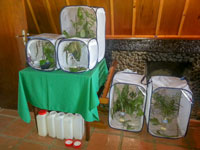First of all, you should take in mind that for most countries, collecting permits do not include the export (especially if you want to export alive insects). You need to apply for an additional permit.

Right here it shall be said, that even if one is only searching for specimens he or she wishes to have for the cabinet, should keep the females alive as long until they have laid a few eggs. These are the most reliable tools for the identification of phasmids!
As long as you are at your collecting site or residence, hanging cages made of mosquito-net with heights between 50-100 cm with a zip have proven to be very useful for keeping phasmids alive on vacation. For preventing the humidity to decrease, the cage is covered with a large polythene bag, which is sealed at the top. These net-cages are very lightweight and do not need much space in one's luggage, due to being made of two rigid plastic or metal rings and very thin and flexible mosquito net. While collecting the insect at night, several stems or branches of the plants on which they were found should be cut and placed into the cage. Due to these net-cages hanging free, the phasmids are safe from being attacked ants, which may be the case if plastic boxes are used. Nevertheless, smaller species are better stored in suitable, rigid plastic containers or plastic bottles, which have plenty of air-holes or a piece of gauze in their lids.
A piece of gauze in the lid of the container gives the insects another possibility of recline. But as already said, care should be taken of ants which readily attack insects, stored in boxes or bottles, especially in tropical regions. Suitable containers or storing the eggs are e.g. the containers for camera-films or Eppendorf.
Due to the large size and long awkward legs of many species which are easily dropped (autotomy), phasmids are quite difficult to transport, especially if one wishes to bring home life insects. Apart from their size, there are two major considerations one should take into account when transporting livestock: preventing crushing and preventing overheating or dehydration. The air conditions strongly dehydrate the air, which causes the transport boxes with the insects to dry out rapidly. It has proven successful to use almost air-tight containers with only a very few air-holes, as not too much air for breathing is needed for just a few hours. Fresh samples of the food plant should be wedged in the container so they do not fall on the insects and the bottom of the container should be covered with damp toilet paper. Preventing the insects of being crushed can be solved by using rigid boxes and trying to avoid rough handling of the baggage. Overheating is a much more serious problem and can easily occur when travelling in a vehicle which is not air-conditioned or similar. The only thing to do is try to ensure that the insects are kept in the shade and is never directly exposed to the sun. Air travel brings one to the decision whether to keep the livestock as hand luggage or better have it stored in the holds of the aircraft. The holds of a large, modern aircraft are pressurized and a Boeing 747, for example, maintains a hold temperature of 15-18°C which is quite ideal for most phasmids. We have made the experience that having the livestock stored in the holds is more sufficient and safe, rather than keeping them as hand luggage.
Another possibility to bring the insects home alive is to send them by air-mail (check first if it is legal in both countries, origin and destination). This does, however, pretend on the country or region you are, as good infrastructure and reliable mailing system is needed to ensure the insects to arrive at their destination safely. It is always wise to use a post-office in a large city or nearby an international airport.
Also when posting the livestock, one should use rigid, quite air-tight containers with only a very few air-holes, with plenty of humidity and fresh food. Better give the insects a little less space but more food plants instead! The food plants should be safely wedged in the container to prevent them from falling on the insects. The stable freezing-boxes of “Rubbermaid” or Tupperware” have proven very suitable for posting live phasmids.
Predominantly these methods are suitable for more robust phasmids (e.g. Haaniella, Aretaon, Creoxylus) and insects with maximum body lengths of 10 cm. Very large species (e.g. Pharnacia, Acrophylla) are very difficult to transport without being damaged.